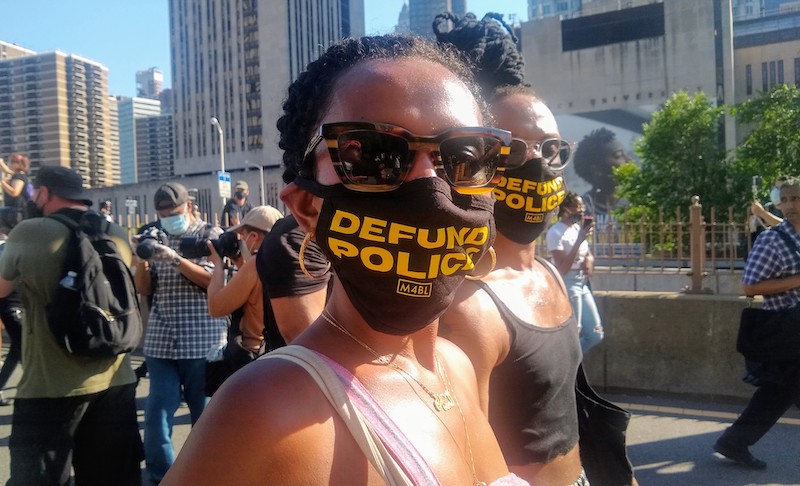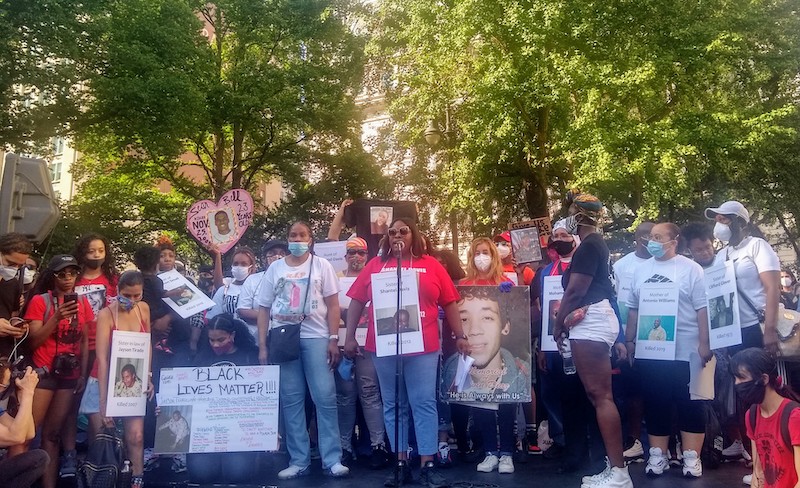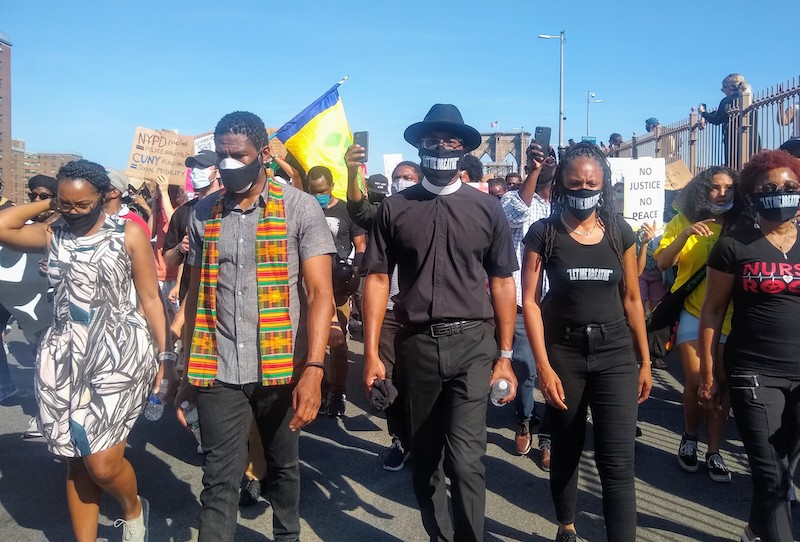About two weeks into the relentless display of social activism sparked by the death of George Floyd and others, yesterday afternoon’s rally on the steps of Brooklyn’s Borough Hall, rang with a single chant of “Defund The Police.”
The demand for specific, tangible, and impactful changes to the NYPD and policing oversight, such as slashing the police department’s roughly $6 billion dollar budget by $1 billion, has picked up steam lately.
Public Advocate Jumaane D. Williams, Councilmember Brad Lander (Cobble Hill, Carroll Gardens, Columbia Waterfront, Gowanus, Park Slope, Windsor Terrace, Borough Park, Kensington), Black Lives Matter advocates, elected officials and staffers, clergy members, and protesters want that money reinvested into other essential social services whose budgets were cut because of the COVID-19 crisis.
They went from Borough Hall, to silently marching across the Brooklyn Bridge, and ending at City Hall with families of New Yorkers killed by police, on Tuesday, June 9, in full support of scaling back the NYPD’s funding.
Williams said that Mayor Bill De Blasio hadn’t provided any leadership when it came to the protests, “and after 10, 11 days of unrest that was righteous and needed and anger and painful, he put out four weak-ass points to respond to all of the pain that’s going on across this city and across this country. That’s unacceptable.” He applauded city council and assembly for admitting mistakes and understanding that the answer to a massive protest about over-policing and brutality is not more police.

“When what the NYPD does is respond to a passionate outcry of peaceful protests against abusive policing with more abusive policing, and then doesn’t tell the truth about it. We know the time for small incremental reform is passed,” said Lander. “I want to say thank you to the 42,000 people who called or emailed my office demanding that I take steps to defund the NYPD.”
Speakers at the rally also emphasized that the police often respond to situations that don’t require their presence or have the potential for violence, such as mental health emergencies.
Borough President Eric Adams, who spoke briefly at the rally but didn’t end up marching, said, “I’m not here to dictate to you. I’m not here to tell you how angry you should be or shouldn’t. I’m not here to tell you you should walk or how you shouldn’t walk. This is your moment, you are the grandchildren of the civil rights workers.”
Once the rally concluded, Williams and the crowds began marching towards the bridge. Protesters could barely contain their chants and yells in favor of the power of silence as they approached the police barricading the entrance. After a tense moment, the parade of protesters were allowed to pass without incident.
At the executive budget hearings four weeks ago, Williams was asking for cuts to the NYPD budget to fund youth and community development as well as social and children’s services during the city’s recovery from COVID-19. The budget for many departments had been cut severely while the police department’s $5.64 billion had remained virtually untouched, engendering a flurry of criticism.
New York City Police Commissioner Dermot Shea was quoted in the meeting citing problems, like “career criminals” released because of bail reforms, had to be combatted.
Williams, BP Adams, and other Brooklyn officials had also loudly protested the suspension of the $124 million Summer Youth Employment Program, which they stated, helped to curb gun violence in neighborhoods by providing opportunities.
The debate about cutting and/or defunding comes as violent crime has been increasing in Brooklyn. According to recent NYPD Compstats, the borough is seeing an increase in murders, shooting incidents and shooting victims since this time last year. There have been 49 reported murders as of May 31 this year including 125 shooting incidents resulting in 140 shooting victims as compared to 41 reported murders, 101 shooting incidents and 117 shooting victims as of May 31 in 2020.
In the last two days Shea has at least noted his monumental support behind shifting some funding from the police to youth programs. “It’s incumbent upon all of us to dig down and do what’s needed,” said Shea to Pix11, “To help the kids of this city, I’m 1,000% behind that.”
Williams, his wife, and other officials headed the pack of protesters across the bridge highways, cutting off traffic at the on-ramps. Onlookers and media snapped pictures at them from above on the pedestrian walkways while helicopters hovered above even higher. They knelt at the bridge’s halfway point for 8 seconds, symbolically counting out loud in unison each minute it took George Floyd to stop breathing.
At the mouth of the bridge entrance on the Manhattan side the protesters met up with the ‘Rise Up with the Families’ demonstrations in front of City Hall.

The close families of people slain by the police were present to tell their stories: Antonio Williams and Allan Feliz in 2019; Saheed Vassell in 2018; Delrawn Small in 2016; Elvin Diaz in 2015; Kimani Gray in 2013; Shantel Davis, Mohamed Bah, and Ramarley Graham in 2012; Jayson Tirado in 2007; Sean Bell in 2006; and ten-year-old Clifford Glover in 1973.
“We are here in solidarity,” said advocate Natasha Duncan from East Flatbush, whose sister was police shooting victim Shantel Davis. “We are sick and tired of systematic racism and injustice. There are families that have been fighting for two decades.”
“There are too many names,” she screamed.






